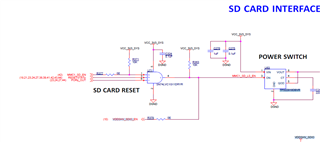Other Parts Discussed in Thread: AM62P, SYSCONFIG, AM62P5-Q1
Tool/software:
Hi TI Experts,
Is there a list of design recommendations or commonly observed errors for SD card Interface during Custom board hardware design?
Below are some common queries i have
1. Pullup recommendations
2. Power supply and Sequencing
3. Series resistor for SD card clock output from the processor
4. Power switch for SD card reset


